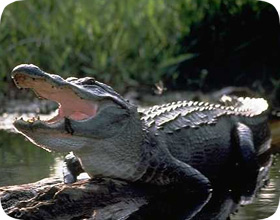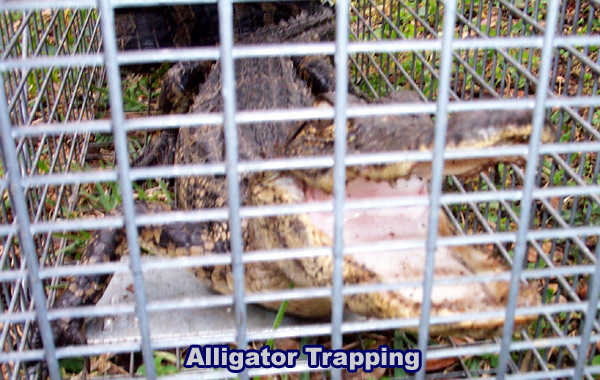-
info@aaanimalcontrol.com
Call us for help in you town
Humane Wildlife Education
Alligator Trapping
The primary means of alligator trapping is through the use of a hook or snare attached to a very strong rope, baited with fish, and suspended below a very large float. Traditional steel snare sets can also be used. Most alligator
trapping is done by licensed professionals, of course.
 Alligators are some of the oldest living species on the earth, dating back to prehistoric times. There are two types of alligators, and they are known to live near lakes, swamps, rivers and other fresh water areas. The babies can grow up to
be adults 15 feet long and be over 1000 lbs in weight. However, it was recorded in Louisiana that one was found over 19 inches long. Imagine that!
Alligators are some of the oldest living species on the earth, dating back to prehistoric times. There are two types of alligators, and they are known to live near lakes, swamps, rivers and other fresh water areas. The babies can grow up to
be adults 15 feet long and be over 1000 lbs in weight. However, it was recorded in Louisiana that one was found over 19 inches long. Imagine that!
Most people are concerned about alligators if they become too large, and might pose a threat to pets or people. Yes, it does happen: alligators do sometimes attack and kill both people and
pets. However, this is rare, and most attacks come during the mating season in late spring.
Need American Alligator removal in your hometown? We service over 500 USA locations! Click here to hire us in your town and check prices - updated for year 2020.
Alligators are not a pest in the traditional sense of the word. These large reptiles can live to be over one hundred years old, and are not wandering into yards to dig up landscaping or to invade the homeowner’s attic. When an alligator is near your home,
the reason that alligator needs to be removed is because it is an immediate threat to any children or pets in the vicinity. Even adults have plenty to worry about when it comes to the rogue alligator, no matter what its size. An alligator near your home
or in your swimming pool is a major cause for concern, and it is not a situation you should attempt to handle on your own. Even wildlife professionals are limited when dealing with this specific reptile. Only certain experts will have the correct equipment
and permits to be able to remove an alligator. So if you're looking for specific alligator trapping information so you know how to catch an alligator, I'll say here, but that doesn't mean you're going to successfully do it.

The damage caused by an alligator to a human or domestic animal is generally inflicted by the alligator’s teeth. These teeth will sink into flesh, locking the alligator’s jaw while the reptile tries to twist the piece of meat off the main body. You can imagine the kind of traumatic injuries this can cause to an arm or leg. Current statistics show that most alligator bites occur in Florida, though a handful of other southern states have alligators as native residents.
Currently, the best methods for preventing alligators from becoming nuisances have been methods involving exclusion of the animal near human dwellings whenever possible. This is accomplished by building large, concrete bulkheads above the water, preventing the alligators from basking on shorelines. Fences are also being used. The fence must be over five feet high and must angle outward. Documented cases exist of alligators climbing fences to get at family pets. In addition to exclusion, habitat modification is also being used, though wetlands are protected by law. In public areas, vegetation modification is often allowed, eliminating brush that might shelter an alligator. There are no repellents and no toxicants for alligators.
When the wildlife expert arrives to remove the problem alligator, he or she will be equipped with either a live-trap or the acceptable harvesting method for your area. Trapping is dangerous, and often must be done with a baited hook. Snare traps and net traps are less effective, but do not intentionally harm the alligator. Once the alligator is trapped, the animal’s jaw is taped shut. This feat is accomplished by trained professionals using a variety of tactics, one of which includes blindfolding the animal. It takes an immense amount of strength, speed, and agility to wrestle with an alligator, and many professionals have employed the use of tranquilizers. Injections administered while the reptile is on the snare or hook will sedate it enough for handling and relocation. Alligator sedation is not an exact science because the animal is not weighed prior to dosage. This variance results in unpredictable durations of effect for the anesthetic. Prompt action on the part of the authorities is important if relocation is an option. Depending on the area you are located in, the alligator may be humanely euthanized on site. Some local governments do not allow relocation of problem alligators, and studies show relocated gators are likely to return to the site of capture after being released.
Alligator trapping removal is not something to be taken lightly, and dozens of people are seriously injured every year by alligator attacks. Alligators are remarkably camouflaged while in the tall grass along a shore, and many pets have fallen victim to the reptiles
because of this stealthy attribute. If a pet can be caught unawares, you stand even less of a chance. Do not take on this predator by yourself. So the bottom line for how to trap an alligator? Call a professional.
Read more about Orlando alligator info here.
Read more about how to get rid of alligators here.


















